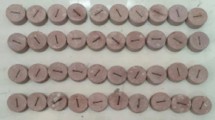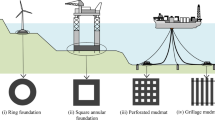Abstract
Discrete element simulations of one-dimensional compression of breakable granular assemblies were performed to investigate the capability of the exponential compression equation suggested by Bauer. The relationship between the so-called solid hardness and the particle strength was studied so as to provide a physical background for the introduction of a time-dependent solid hardness. A hyperbolic flow rule, describing the relationship between the inclination of the strain path and the stress ratio during wetting, was proposed based on typical triaxial wetting experiments on two different rockfill materials. The flow rule was then extended and incorporated into the transformed stress based hypoplastic model to capture the direction of creep strains. Meanwhile, a new density factor was introduced to the extended model to take into account the dependence of the magnitude of creep strains on the packing density. The stiffness tensor given by the extended model was discussed and the flowchart for the integration of the constitutive equation was designed. The extended model was then embedded into a finite element program and used to simulate the triaxial compression and wetting experiments performed on the aforementioned rockfill materials. Good agreement between the model predictions and the measured results lends sufficient credibility to the extended model in reproducing the stress-stain behaviour under loading and the creep behaviour during wetting. The extended model and the finite element program were also used to investigate the deformation behaviour of an earth-rock dam at the end of construction and during first impounding. The familiar phenomena such as the wetting induced settlement of the upstream shell and the movement of the dam crest towards the upstream were successfully captured by the numerical model, which confirms the feasibility of applying the extended model to dam engineering in the future.
Similar content being viewed by others
References
Gu G C, Shu Y M, Shen C S. Experience and Innovation in Earth-rock Dam Engineering. Beijing: China Electricity Publication Press, 2004
State Council of China. Comprehensive Schemes for the Energy-saving and Emission-reducing Works during the Twelfth-five Years Plan, Beijing, 2011
Alonso E E, Cardoso R. Behaviour of materials for earth and rockfill dams: Perspective from unsaturated soil mechanics. Front Archit Civ Eng China, 2010, 4(1):1–39
Fu Z Z, Gao J J, Liu S H. On one-dimensional compression of breakable granular materials. In: Jia J S, Zhang S G, Xu Z P, et al., eds. Studies on Modern Technologies and Long-term Behaviour of Dams. Beijing: China Water Power Press, 2011. 63–69
Nobari E S, Duncan J M. Effect of Reservoir Filling on Stresses and Movements in Earth and Rockfill Dams. Report of Department of Civil Engineering, University of California, TE-72-1, 1972
Fu Z Z, Liu S H, Li Z. Discrete element simulations of two wetting effects on granular materials. Chinese Sci Bull, 2011, 56(35):3803–3811
Oldecop L A, Alonso E E. Theoretical investigation of the time-dependent behaviour of rockfill. Géotech, 2007, 57(3):289–301
Takei M, Kusakabe O, Hayashi T. Time-dependent behavior of crushable materials in one-dimensional compression tests. Soils Found, 2001, 41(1):97–121
Wei S. Study on Wetting Deformation Behavior and Numerical Model of Coarse-grained Materials. Dissertation of Doctoral Degree. Nanjing: Hohai University, 2006
Fang X S. Test Study and Numerical Simulation on Wetting Deformation of Gravel Sand. Dissertation of Masteral Degree. Nanjing: Hohai University, 2005
Oldecop L A, Alonso E E. A model for rockfill compressibility. Géotech, 2001, 51(2):127–139
Cetin H, Laman M, Ertunc A. Settlement and slaking problems in the world’s fourth largest rock-fill dam, the Ataturk Dam in Turkey. Engng Geol, 2000, 56:225–242
Shen Z J, Wang J P. Numerical simulation of construction behaviour of clay core dam and its movement due to reservoir impounding. Hydro-Sci Eng, 1988, 4:48–63
Li G Y, Wang L S, Mi Z K. Reseach on stress-strain behaviour of soil core rockfill dam. Chinese J Rock Mech Eng, 2004, 23(8):1363–1369
Bauer E. Hypoplastic modelling of moisture-sensitive weathered rockfill materials. Acta Geotech, 2009, 4:261–272
Bauer E, Fu Z Z, Liu S H. Hypoplastic constitutive modelling of wetting deformation of weathered rockfill materials. Front Archit Civ Eng China, 2010, 4(1):78–91
Gudehus G. A comprehensive constitutive equation for granular materials. Soils Found, 1996, 36(1):1–12
Bauer E. Calibration of a comprehensive hypoplastic model for granular materials. Soils Found, 1996, 36(1):13–26
Fu Z Z, Bauer E. Hypoplastic constitutive modeling of the long term behaviour and wetting deformation of weathered granular materials. In: Bauer E, Semprich S, Zenz G, eds. Proceeding of the 2nd International Conference on Long Term Behaviour of Dams. Graz, 2009. 473–478
Huang W X, Sun D A, Sloan S W. Analysis of the failure mode and softening behavior of sands in true triaxial tests. Int J Solids Struct, 2007, 44:1423–1437
Lade P V. Assessment of test data for selection of 3-D failure criterion for sand. Int J Numer Anal Meth Geomech, 2006, 30:307–333
Lade P V. Instability, shear banding, and failure in granular materials. Int J Solids Struct, 2002, 39:3337–3357
Huang W X, Sloan S, Fityus S. Incorporating a predefined limit condition in a hypoplastic model by means of stress transformation. Mech Mater, 2008, 40:796–802
Oquendo W F, Muñoz J D, Lizcano A. Oedometric test, Bauer’s law and the micro-macro connection for a dry sand. Comp Phys Comm, 2009, 180:616–620
Guerrero S L, Vallejo L E. Analysis of crushing of granular material under isotropic and biaxial stress conditions. Soils Found, 2005, 45(4):79–87
Guerrero S L, Vallejo L E. Modeling granular crushing in ring shear tests: Experimental and numerical analysis. Soils Found, 2006, 46(2):147–157
Nakata Y, Kato Y, Hyodo M, et al. One-dimensional compression behaviour of uniformly graded sand related to single particle crushing strength. Soils Found, 2001, 41(1):39–51
Nakata Y, Hyodo M, Hyde A F L, et al. Microscopic particle crushing of sand subjected to high pressure one-dimensional compression. Soils Found, 2001, 41(1):69–82
Li G X. Triaxial Experiments on Dry and Saturated Rockfill Materials Used in Xiaolangdi Earth Dam. Research Report from Tsinghua University, 1988
Li G X. Triaxial Wetting Experiments on Rockfill Materials used in Xiaolangdi Earth Dam. Research Report from Tsinghua University, 1988
Itskov M. Tensor Algebra and Tensor Analysis for Engineers with Applications to Continuum Mechanics. Berlin: Springer-Verlag, 2007
Matsuoka H, Yao Y P, Sun D A. The cam-clay models modified by the SMP criterion. Soils Found, 1999, 39(1):81–95
Bauer E. Conditions for embedding Casagrande’s critical states into hypoplasticity. Mech Cohes-Frict Mater, 2000, 5:125–148
Oda M. Co-ordination number and its relation to shear strength of granular material. Soils Found, 1977, 17(2):29–42
Ueng T S, Chen T J. Energy aspects of particle breakage in drained shear of sands. Géotech, 2000, 50(1):65–72
Herle I, Gudehus G. Determination of parameters of a hypoplastic constitutive model from properties of grain assemblies. Mech Cohes-Frict Mater, 1999, 4:461–486
Lewis R W, Schrefler B A. The Finite Element Method in the Deformation and Consolidation of Porous Media. New York: John Wiley & Sons., 2000
Zienkiewicz O C, Chan A H C, Pastor M, et al. Computational Geomechanics with Special Reference to Earthquake Engineering. New York: John Wiley & Sons., 1999
Fu Z Z, Liu S H. Formulations of a hydromechanical interface element. Acta Mech Sin, 2011, 27(5):697–705
Krahn J. Seepage modeling with SEEP/W an engineering methodology. GEO-SLOPE Ltd. Calgary, Alberta, 2004
Sheng D C, Sloan S W, Gens A, et al. Finite element formulation and algorithms for unsaturated soils. Part I: Theory. Int J Numer Anal Meth Geomech, 2003, 27:745–765
Sheng D C, Smith D W, Sloan S W, et al. Finite element formulation and algorithms for unsaturated soils. Part II: Verification and application. Int J Numer Anal Meth Geomech, 2003, 27:767–790
Author information
Authors and Affiliations
Corresponding author
Rights and permissions
About this article
Cite this article
Fu, Z., Chen, S. & Liu, S. Hypoplastic constitutive modelling of the wetting induced creep of rockfill materials. Sci. China Technol. Sci. 55, 2066–2082 (2012). https://doi.org/10.1007/s11431-012-4835-4
Received:
Accepted:
Published:
Issue Date:
DOI: https://doi.org/10.1007/s11431-012-4835-4




